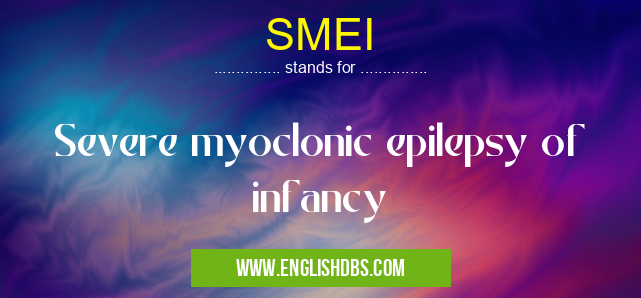What does SMEI mean in HOSPITALS
SMEI (Severe Myoclonic Epilepsy of Infancy) is a rare and severe form of epilepsy that typically affects infants during the first year of life. It is characterized by seizures that involve sudden, involuntary muscle contractions (myoclonic seizures). These seizures can be frequent and can severely impact the child's development and quality of life.

SMEI meaning in Hospitals in Medical
SMEI mostly used in an acronym Hospitals in Category Medical that means Severe myoclonic epilepsy of infancy
Shorthand: SMEI,
Full Form: Severe myoclonic epilepsy of infancy
For more information of "Severe myoclonic epilepsy of infancy", see the section below.
Causes and Symptoms
The exact cause of SMEI is unknown, but it is believed to be caused by a genetic abnormality that affects the brain's electrical activity. SMEI symptoms typically begin between 3 and 6 months of age and may include:
- Frequent myoclonic seizures: These seizures are brief, sudden, and involuntary muscle contractions that can affect any part of the body.
- Other seizure types: Some children with SMEI may also experience other types of seizures, such as tonic-clonic seizures (grand mal seizures).
- Developmental delays: SMEI can lead to developmental delays in motor skills, language, and cognitive function.
- Behavioral problems: Children with SMEI may also exhibit behavioral problems, such as hyperactivity, aggression, and sleep disturbances.
Diagnosis
Diagnosing SMEI can be challenging as the symptoms are similar to those of other conditions. Tests used to diagnose SMEI may include:
- Electroencephalogram (EEG): An EEG records the electrical activity of the brain and can detect the characteristic seizure patterns associated with SMEI.
- Genetic testing: Genetic testing can identify mutations in genes that are associated with SMEI.
- Metabolic testing: Metabolic testing can rule out other conditions that may cause similar symptoms, such as organic acidurias.
Treatment
Treatment for SMEI focuses on controlling seizures and managing symptoms. Treatment options may include:
- Anticonvulsant medications: Medications such as valproic acid, levetiracetam, and topiramate are commonly used to control seizures in children with SMEI.
- Ketogenic diet: A ketogenic diet is a high-fat, low-carbohydrate diet that has been shown to reduce seizures in some children with SMEI.
- Vagus nerve stimulation (VNS): VNS is a surgical procedure that involves implanting a device that stimulates the vagus nerve, which helps regulate brain activity.
- Palliative care: Palliative care focuses on providing comfort and support to children with SMEI and their families.
Essential Questions and Answers on Severe myoclonic epilepsy of infancy in "MEDICAL»HOSP"
What is Severe Myoclonic Epilepsy of Infancy (SMEI)?
SMEI is a rare epileptic encephalopathy characterized by severe myoclonic seizures that begin in the first few months of life. These seizures are often refractory to treatment and can lead to significant developmental delays.
What are the symptoms of SMEI?
The hallmark symptom of SMEI is frequent, brief, shock-like myoclonic seizures that can involve all four limbs and the body. Other symptoms may include: developmental delay, intellectual disability, spasticity, and autistic features.
What causes SMEI?
SMEI is caused by mutations in the SCN1A gene, which encodes a sodium channel protein essential for regulating neuronal excitability. These mutations lead to abnormal neuronal activity and the development of seizures.
How is SMEI diagnosed?
SMEI is diagnosed based on the characteristic seizure type, electroencephalography (EEG) findings, and genetic testing. The EEG typically shows a distinctive pattern of high-amplitude, fast-wave activity. Genetic testing can confirm the presence of SCN1A mutations.
What is the treatment for SMEI?
Treatment for SMEI focuses on seizure control and management of developmental issues. Anti-seizure medications, such as clobazam and valproate, may be used to reduce the frequency and severity of seizures. Physical and occupational therapy can help improve motor function and developmental skills.
What is the prognosis for SMEI?
The prognosis for SMEI varies. Some children experience significant developmental delays and may require lifelong support. Others may have milder symptoms and achieve better outcomes. The overall prognosis depends on the severity of seizures and the presence of additional developmental issues.
What research is being done on SMEI?
Ongoing research aims to better understand the genetic basis of SMEI, develop new treatment strategies, and improve the prognosis for affected individuals. Researchers are investigating the role of other genes, exploring gene therapy approaches, and conducting clinical trials to evaluate new therapies.
Final Words: SMEI is a complex and challenging condition that requires specialized care and support. Early diagnosis and prompt treatment are essential for improving outcomes and reducing the impact of the seizures on the child's development and quality of life. Continuous research into the causes, diagnosis, and treatment of SMEI is ongoing to improve the lives of affected children and their families.
SMEI also stands for: |
|
| All stands for SMEI |
